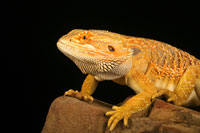Advice on breeding reptiles from Russ Case.
If you’ve been keeping reptiles for years you may be thinking about trying to breed them. This would be a logical step in your progression in the hobby. Breeding reptiles can certainly provide a wonderful new facet, but before you try, there is something you should consider.

Bearded dragons are a natural for first-time reptile breeders to work with. They will often breed readily in captivity, which is one reason they have become such popular pets.
Let’s use bearded dragons as an example, because the bearded dragon is a very popular reptile pet and one a lot of people may decide to try breeding, especially people who are trying it for the first time.
Bearded dragons are a good choice with which to start. Breeding stock is readily available and the bearded dragon is one species that is known to breed fairly readily in captivity, sometimes even if you weren’t actually planning for them to do so. If your bearded dragons do breed successfully, you could end up with a clutch of eggs numbering up to about 25. Let’s assume you maintain them properly during the incubation period and all of the eggs hatch out into cute little baby bearded dragons. Now you’ve got 25 additional bearded dragons.
What are you going to do with them? Perhaps your plan was to sell them. Does your local pet store buy from private breeders? Is there a reptile expo coming to town, and you were thinking of setting up a table there in order to sell your beardies? Maybe you were toying with the idea of running a classified ad in your local newspaper, or in the classifieds section of REPTILES magazine. Or maybe you weren’t planning to sell your baby beardies. In that case, are you prepared to care for that many bearded dragons?
I’ve written about the evils of impulse buying many times, but there is also the scenario of what might be called “impulse breeding.” This would be breeding your reptiles without any idea of what you will do with the offspring if you are successful. If you are successful, though, you will be responsible for a bunch of new reptiles, and that is not something that should be taken lightly.
If you want to try your hand at breeding your pet reptiles, that’s great. Just know what your next step will be. For instance, you could talk to your local pet stores before you actually make your attempts, to see if they would be willing to buy your babies. Or research herp societies to see if there are any local clubs in your area and whether or not their members may have suggestions that would be helpful. Maybe some of them would even be willing to buy your bearded dragons. Another option is to approach schools, universities, museums and anywhere else that may have a use for live reptiles, whether in displays or for educational purposes.
Of course you don’t have to start breeding with a species that lays a bunch of eggs in each clutch. Another option would be to try your first reptile breeding experiments with a species that is not quite as prolific when it comes to the number of eggs that are produced. Crested geckos, for instance, lay only a couple at a time. But you’ll still need to know what you will be doing with the babies once they arrive.
Regardless of which avenue you ultimately end up taking – selling or keeping any babies you hatch out – by having a game plan in mind you will be the best kind of reptile breeder: a responsible one.


